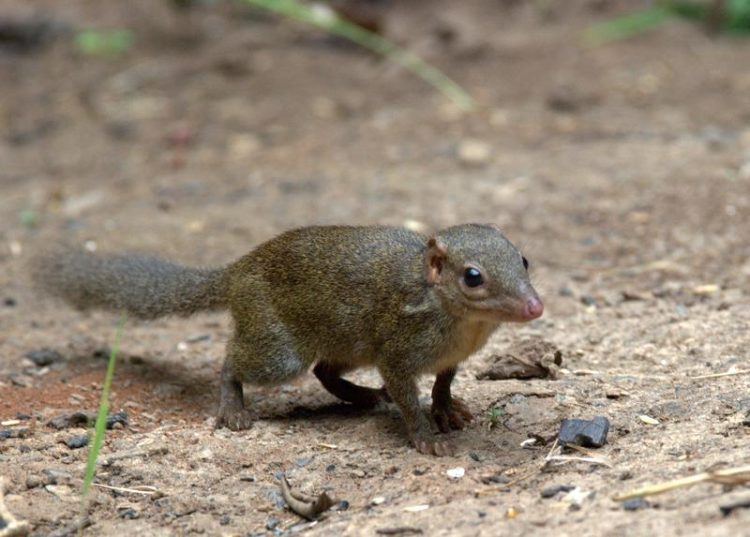Climate change: Tropical species are most vulnerable to rising temperatures

The Northern Treeshrew is an indige-nous mammal in tropical Southeast Asia. The thermal tolerance of this species is only 7.5 degrees, which is quite narrow.
In contrast, a large part of mammal and bird species in temperate zones will find ambient temperatures in 2080 within their tolerance ranges. However, indirect effects of rising temperatures may counteract opportunities given by species’ physiological tolerances in temperate zones.
In responding to changing ambient conditions, species become extinct, adapt or move to a different, more suitable habitat. One of the largest studies of this kind was carried out by researchers from the German LOEWE Biodiversity and Climate Research Centre (BiK-F) and Goethe University. The study highlights the alternative idea that the species may also just be able to tolerate the ongoing changes.
The researchers selected nearly 460 mammal and bird species and analyzed their tolerated temperature ranges. These estimations were subsequently matched with data from geographical distributions and temperatures in these habitats currently and under projected climatic conditions in 2080. The analyzed species are a representative selection of physiological diversity within the global bird and mammal species.
Are species in temperate zones unmoved by climate change?
From a global perspective, 54% of the bird and 62% of the analyzed mammal species will experience temperatures above their tolerated threshold across 50% of their current distribution for a certain period of time. “However, we found significant regional differences. In 2080 the majority of the analyzed mammal and bird species living in the temperate zones will likely find suitable temperature conditions in a large part of their habitat. But they are not off the hook, because rising temperatures might have indirect effects. For instance, higher temperatures may improve conditions for pathogens or competing species and have negative impacts on the occurrence of food resources,” says Dr. Christian Hof, Biodiversity and Climate Research Centre (BiK-F).
Species-rich tropical regions are most vulnerable to rising temperatures
The share of species which will experience temperatures above their tolerated threshold increases from polar and temperate regions towards tropical regions, even though increases of temperature projected for temperate and polar regions exceed those in the tropics. “Bird and mammal species living in tropical regions tend to live closer to their upper temperature limits. Even small increases in ambient temperatures may therefore challenge their long-term survival,“ explains the lead author of the study, Imran Khaliq, a current PhD student at BiK-F. In addition, projections show decreasing precipitation in tropical regions. This worsens the perspective for tropical species as water availability is crucial for endotherm species (such as mammals and birds) to compensate thermal stress.
Birds adapt physiologically to ambient climate, mammals adapt by behavior
Projections of mammal responses to climate change may contain a substantial component of uncertainty as the data show a higher independence of physiologically-tolerated temperatures and climatic conditions in their habitats when compared to birds. This may be due to differing strategies in coping with extreme temperatures. While in birds, physiological adaptations appear to dominate their strategies to cope with extreme temperatures, mammals have developed behavioral strategies to cope with climatic extremes, e.g. creating preferred microclimates in burrows and dens.
Paper:
Khaliq, I., Hof, Ch. et al. Global variation in thermal tolerances and vulnerability of endotherms to climate change – Proceedings of the Royal Society B: Biological Sciences. DOI: 10.1098/rspb.2014.1097
For more information please contact:
Dr. Christian Hof
LOEWE Biodiversity and Climate Research Centre (BiK-F)
Tel. + 49 (0)69 7542 1804
christian.hof@senckenberg.de
or
Sabine Wendler
LOEWE Biodiversity and Climate Research Centre (BiK-F)
Press officer
Tel. +49 (0)69 7542 1838
sabine.wendler@senckenberg.de
Media Contact
More Information:
http://www.senckenberg.deAll latest news from the category: Ecology, The Environment and Conservation
This complex theme deals primarily with interactions between organisms and the environmental factors that impact them, but to a greater extent between individual inanimate environmental factors.
innovations-report offers informative reports and articles on topics such as climate protection, landscape conservation, ecological systems, wildlife and nature parks and ecosystem efficiency and balance.
Newest articles

Long-sought structure of powerful anticancer natural product
…solved by integrated approach. A collaborative effort by the research groups of Professor Haruhiko Fuwa from Chuo University and Professor Masashi Tsuda from Kochi University has culminated in the structure…

Making a difference: Efficient water harvesting from air possible
Copolymer solution uses water-loving differential to induce desorption at lower temperatures. Harvesting water from the air and decreasing humidity are crucial to realizing a more comfortable life for humanity. Water-adsorption…

In major materials breakthrough
UVA team solves a nearly 200-year-old challenge in polymers. UVA researchers defy materials science rules with molecules that release stored length to decouple stiffness and stretchability. Researchers at the University…



